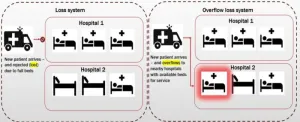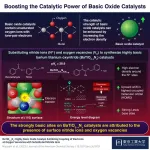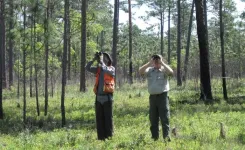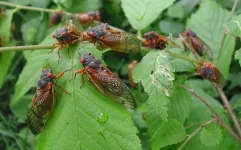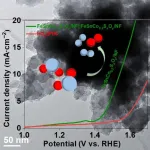(Press-News.org) New study tackles the mystery of why bacteria often carry diverse ranges of weapons.
The findings show that different weapons are best suited to different competition scenarios.
Short-range weapons help bacteria to invade established communities; long-range weapons are useful once established.
A new study led by the University of Oxford has shed light on why certain species of bacteria carry astonishing arsenals of weapons. The findings, published today in the journal Nature Ecology & Evolution, could help us to engineer microbes that can destroy deadly pathogens, reducing our reliance on antibiotics.
Many species of bacteria possess multiple weapons to attack competitors. These include both short-range weapons that require direct contact with neighbouring cells, and long-range weapons, such as toxins that are released into the environment. Up to now, why bacteria have evolved to carry such a wide array of weapons has been a mystery.
Study co-author Professor Kevin Foster (Departments of Biology and Biochemistry, University of Oxford), said: ‘Unlike animals, which tend to carry a single weapon type such as horns, antlers, or tusks, bacterial species commonly carry multiple weapons. But it was unclear what the evolutionary basis for this was – why not just invest in a single type? One theory was that bacteria carry multiple weapons because they serve different functions during competition.’
The researchers tested this using the opportunistic pathogen Pseudomonas aeruginosa, a priority one pathogen by the World Health Organization, due to the rapid emergence of multidrug-resistant strains. P. aeruginosa possesses diverse weapons, including the ability to produce various toxic molecules (a long-range weapon), and toxin-loaded filaments anchored to its outer membrane (a short-range weapon).
The team designed a series of experiments to determine under which conditions short- versus long-range weapons give a greater advantage. They used genome editing to generate P. aeruginosa strains that lacked and were susceptible to either the toxin-loaded filaments or long-range toxins called tailocins. The susceptible strains were then grown on agar plates with control P. aeruginosa over two days, at a series of different ratios. Because the strains each expressed a different fluorescent protein, the researchers could quantify the ratio of attacker vs susceptible bacteria.
The results clearly demonstrated that the two weapons perform best under different conditions. Tailocins, the long-range weapon, only became effective when the attacking bacteria were at a high density and more common than the competition. On the other hand, carrying toxin-loaded filaments gave a competitive advantage over a much greater range of conditions. This included situations when the attacking bacteria were only present in low initial numbers and had to compete with a larger population of susceptible bacteria.
The researchers then challenged the two engineered strains in direct head-to-head competitions. When the strains started at an equal frequency, the bacteria carrying toxin-loaded filaments had a distinct advantage. However, both weapon users were able to win when they started in the majority.
Moreover, when cells could use both weapons simultaneously, they were able to suppress susceptible bacteria significantly better than strains that used only one weapon, demonstrating that the short- and long-range weapons complemented each other.
According to the researchers, the results show that short- and long-range weapons perform differently depending on the competition scenario. Co-author Dr Sean Booth (University of Oxford) said: ‘Our results demonstrate that a particular advantage of contact-dependent weapons is that they are effective even when users are at a numerical disadvantage. This suggests that they may have evolved to enable bacteria to invade an established population, when they are outnumbered by resident bacteria.’
This theory was supported by a computational model which simulated a low number of attacker cells attacking a larger population of susceptible cells. In the model, cells using short-range weapons were able to successfully invade the community, whereas cells using long-range weapons were not. However, when cells using long-range weapons were present in large numbers and were more common than the competition, these became extremely effective, giving the attackers a significant competitive advantage.
The researchers are now investigating how to apply the findings to custom-design beneficial microorganisms that can out-compete pathogenic strains.
Co-author Dr William Smith (University of Oxford and University of Manchester) said: ‘These results have given us valuable insights into the types of weapons bacteria need to successfully invade and persist in a community. Ultimately, this could help us to develop antibiotic-free ways to fight multi-drug resistant bacteria.’
Notes for editors:
For media enquiries and interview requests, contact Dr Sean Booth, University of Oxford: sean.booth@biology.ox.ac.uk or Dr William Smith: willpjsmith@gmail.com
Images relating to the study are available on request.
The study ‘The evolution of short- and long-range weapons for bacterial competition’ will be published in Nature Ecology & Evolution at 16:00 GMT / 11:00 ET Thursday 30 November 2023 at https://www.nature.com/articles/s41559-023-02234-2 (DOI 10.1038/s41559-023-02234-2). To view a copy of the manuscript before this under embargo, contact Dr Sean Booth, University of Oxford: sean.booth@biology.ox.ac.uk or Dr William Smith: willpjsmith@gmail.com
About the University of Oxford
Oxford University has been placed number 1 in the Times Higher Education World University Rankings for the eighth year running, and number 3 in the QS World Rankings 2024. At the heart of this success are the twin-pillars of our ground-breaking research and innovation and our distinctive educational offer.
Oxford is world-famous for research and teaching excellence and home to some of the most talented people from across the globe. Our work helps the lives of millions, solving real-world problems through a huge network of partnerships and collaborations. The breadth and interdisciplinary nature of our research alongside our personalised approach to teaching sparks imaginative and inventive insights and solutions.
Through its research commercialisation arm, Oxford University Innovation, Oxford is the highest university patent filer in the UK and is ranked first in the UK for university spinouts, having created more than 300 new companies since 1988. Over a third of these companies have been created in the past five years. The university is a catalyst for prosperity in Oxfordshire and the United Kingdom, contributing £15.7 billion to the UK economy in 2018/19, and supports more than 28,000 full time jobs.
END
Armed to the hilt: Study solves mystery behind bacteria’s extensive weaponry
2023-11-30
ELSE PRESS RELEASES FROM THIS DATE:
Gladstone team uncovers why maternal diabetes predisposes babies to heart defects
2023-11-30
SAN FRANCISCO—November 30, 2023—When women with diabetes become pregnant, they face not only the typical challenges of pregnancy and impending parenthood, but also a scary statistic: they’re five times more likely to have a baby with a congenital heart defect.
Researchers at Gladstone Institutes have now discovered why that is, identifying the cells and molecules that go awry in the developing hearts of fetuses in women with diabetes. They found that a small subset of cells destined to become part of the heart’s aorta and pulmonary artery have unusually high levels of retinoic acid activity, which coaxes them to behave more like cells found ...
CityU researchers tackle a century-old teletraffic challenge to enhance medical and public service efficiency
2023-11-30
Efficiently meeting the growing demand for public services in metropolitan areas has long been a persistent challenge. A research team at City University of Hong Kong (CityU) has developed a novel performance evaluation method, which marks a major breakthrough in tackling a century-old problem of evaluating blocking probabilities in queueing systems with overflow, providing ways to allocate limited resources better. With the remarkable advances in computational efficiency and accuracy, the method has great potential to optimise the performance of numerous telecommunication networks and even medical care systems, ultimately enhancing ...
Bringing asteroids to class: COSPAR joins new Erasmus+ program
2023-11-30
COSPAR and the Erasmus+ Education Programme
COSPAR’s participation in Erasmus+ programmes is part of the COSPAR Panel on Education’s new approach to its mission of developing “means and media to encourage and spread space-related education”. The StudenTs As plaNetary Defenders (StAnD) project aims to engage primary and secondary school students in the subject of asteroids, meteors, and planetary defence.
The 36-month StudenTs As plaNetary Defenders (StAnD) programme brings asteroids, comets, meteors and meteorites to the classroom using carefully prepared activities and experiments. The programme includes the installation of meteor detection cameras in participating ...
Developing a superbase-comparable BaTiO3−xNy oxynitride catalyst
2023-11-30
Basic oxide catalysts contain oxygen ions with unpaired electrons that can be shared with other species to facilitate a chemical reaction. These catalysts are widely used in the synthesis of chemicals, pharmaceuticals, and petrochemicals. There have been efforts to improve the catalytic power of these catalysts by improving their basicity or the ability to donate electrons or accept hydrogen ions. Various strategies include doping the catalyst with highly electronegative cations such as alkali metals, substituting oxide ions ...
Hurricanes boost cone production in longleaf pine
2023-11-30
New research on tree reproduction is helping solve a puzzle that has stumped tree scientists for decades. Many tree species exhibit a reproductive phenomenon known as “masting”, where individual trees have very low seed production in most years followed by a sudden burst of seed production that is synchronized over large parts of its range. The reason for this coordinated reproduction within a species is unclear.
A new study by scientists at The Jones Center at Ichauway and the USDA Forest Service Southern Research Station showed ...
Scientists uncover how fermented-food bacteria can guard against depression, anxiety
2023-11-30
University of Virginia School of Medicine researchers have discovered how Lactobacillus, a bacterium found in fermented foods and yogurt, helps the body manage stress and may help prevent depression and anxiety. The findings open the door to new therapies to treat anxiety, depression and other mental-health conditions.
The new research from UVA’s Alban Gaultier, Ph.D., and collaborators is notable because it pinpoints the role of Lactobacillus, separating it out from all the other microorganisms that naturally live in and on our bodies. These organisms are collectively known as the microbiota, and scientists have increasingly ...
Broadband buzz: Periodical cicadas' chorus measured with fiber optic cables
2023-11-30
Annapolis, MD; November 30, 2023—Hung from a common utility pole, a fiber optic cable—the kind bringing high-speed internet to more and more American households—can be turned into a sensor to detect temperature changes, vibrations, and even sound, through an emerging technology called distributed fiber optic sensing.
However, as NEC Labs America photonics researcher Sarper Ozharar, Ph.D., explains, acoustic sensing in fiber optic cables "is limited to only nearby sound sources or very loud events, such as emergency vehicles, car alarms, or cicada emergences."
Cicadas? Indeed, periodical cicadas—the ...
More than $13M awarded to study childhood obesity interventions in rural and minority communities in Louisiana and Tennessee
2023-11-30
BATON ROUGE – Pennington Biomedical Research Center and Vanderbilt University Medical Center have received $13.8 million for five years of research funding from the Patient-Centered Outcomes Research Institute to study the ideal “dose” of behavioral interventions to treat childhood obesity in rural and minority communities across Louisiana and Tennessee.
Pennington Biomedical’s Amanda Staiano and Vanderbilt University Medical Center’s Bill Heerman are co-principal investigators on the randomized, multisite trial.
Despite ongoing efforts, childhood obesity rates have continued to increase over the ...
Decoding past climates through dripstones
2023-11-30
“Dripstones, or speleothems, are unique natural archives - like Earth’s USB sticks. They store a wealth of information on past climate which helps us to better understand the environment in which early humans lived”, Jenny Maccali explains. She is a scientist at SapienCE Centre of Excellence, and has has lead the study, now published in Climate of the Past.
New perspective to ancient climate
South Africa has a highly dynamic climate resulting from its position at the convergence of two oceanic basins, the Atlantic Ocean to the west and the Indian Ocean to the east. ...
Lower voltage and reduced carbon input for cleaner energy in the works
2023-11-30
There is an ever-present struggle to reduce carbon-based energy sources and replace them with low or no-carbon alternatives. The process of splitting water could be the resolution.
Hydrogen production is a simple, safe, and effective method to produce more energy than gasoline can by the simple process of splitting water. Harvesting energy this way as opposed to relying heavily (or at all) on carbon-based energy sources is increasingly becoming the standard. Researchers have found a method to use transition metal ...
